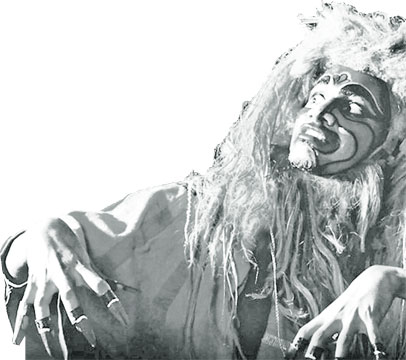 Touched by legend, enriched by lore Touched by legend, enriched by lore
by Dilshan Boange
On July 30, seated in the gentle darkness at the Tower Hall, I
watched one of the hallmark classics of Sinhala theatre, Singhabahu,
written by the late Prof. Ediriweera Sarachchandra, come to life.
Performed with stylized theatrical expressions, Singhabahu is a classic
of the Sinhala theatre that exemplifies the style and form of Sinhala
opera.
The story’s significance is tied to the belief that the origins of
the Sinhala race as per historical narrative based on lore is
genetically transmitted. The textual source that holds the details for
this operatic creation to relate a historical story touched by legend
and enriched by lore (as per modern scrutiny and analysis) is none other
than the Mahavamsa or ‘The Great Chronicle’. Therefore, ‘Singhabahu’,
the son of Princess Suppa Devi and her consort the Lion, is the
eponymous character that seems to show the evolution of a man-lion
hybrid to a stately personage. When contextualized within the narrative
in the Mahavamsa, he is the grandfather of the Sinhala race, as later
on, according to the Mahavamsa, it is his son Prince Vijaya who is
accredited with sowing the seeds of the Sinhala race in the island
nation of Lanka.
Restricted
 In one sense, the transformation of Singhabahu from an obedient son,
dwelling within the confines of the cave, where he, his mother and
sister, Singhaseevali, are restricted to, as per the insistence of the
Lion, out of sincere paternal and spousal concern for his family’s
safety from the perils of the wild jungle that spreads all around, shows
how man renounces ‘mother nature’ in her primordial form as his ordained
domain and limitation, and ventures to ‘discover’ what lies beyond the
folds of nature. The result is manmade ‘culture’ and the concept of
‘statehood’ as the preferred form for human habitation. The character of
Singhabahu can thus be a symbol for man’s divorce from nature to prove
his capability of crafting his own destiny, designed by human desire.
Thus, one may even propound that what is evinced as part of the
ideological veins in this story resonate with the Grecian idea of man’s
inherent need for the ‘polis’, a city, state or community with
government. In one sense, the transformation of Singhabahu from an obedient son,
dwelling within the confines of the cave, where he, his mother and
sister, Singhaseevali, are restricted to, as per the insistence of the
Lion, out of sincere paternal and spousal concern for his family’s
safety from the perils of the wild jungle that spreads all around, shows
how man renounces ‘mother nature’ in her primordial form as his ordained
domain and limitation, and ventures to ‘discover’ what lies beyond the
folds of nature. The result is manmade ‘culture’ and the concept of
‘statehood’ as the preferred form for human habitation. The character of
Singhabahu can thus be a symbol for man’s divorce from nature to prove
his capability of crafting his own destiny, designed by human desire.
Thus, one may even propound that what is evinced as part of the
ideological veins in this story resonate with the Grecian idea of man’s
inherent need for the ‘polis’, a city, state or community with
government.
It is no overstatement, that this play is known (although not
necessarily watched) to nearly every Sri Lankan, owing to its
significance when discussing Sinhala arts and letters, especially,
within the school curricula. Perhaps, the part most familiar is the
song, Gal lena bindala, len dora erala.
At that poignant moment when the Lion discovers that the sealed
entrance to the cave has been sundered, expresses his lament and
indignation in song. I was pleasantly surprised to notice how the young
man seated on my right, appearing to be in his 20s, began singing along,
under his breath, the well known lines of the song.
Theatre as an experience, is not only observing the action unfolding
on the boards; it has also to do with the reactions from the audience
that reflects the connections felt with the performance on stage.
How significant Singhabahu was, as a work of theatre, to that young
man was somewhat evinced by his sotto voce singing.
Singhabahu’s breaking of the stone cover placed over the entrance to
the cave by the Lion, who is a creature of nature, symbolizes the
triumph of human will over nature’s barriers. Singhabahu proves through
his sentiments that he is more human than beast despite being a hybrid
and the breaking free of the rock enclosure marks the first most
significant turning point of the story’s ideology that nature cannot
hold man prisoner anymore.
The next most significant point that brings out the ideological
currents can be seen in Singhabahu’s embracement of life in the city: he
will defend it even against his own father the Lion, who in his rage and
agony sets upon destroying the human habitation.
Conflict
The parts that express the deepest emotional conflict between the
Lion and Princess Suppa Devi were significant aspects of the play.
For the Lion, the torment through song seems most when he realizes
his family has left his abode while for the princess, the greatest
moment of agony seems when she pleads with her son not to set out to
fight his father, the Lion, as she fears her son may not be strong
enough to win.
The ensemble of both actors and the chorus did a good performance
which must be applauded wholeheartedly. Not once did any of the players
fumble with their lines, either verse or dialogues, and of course at
certain points, as monologues.
Reflected
The actors who played the characters of the Lion, Suppa Devi and
Singhabahu stood out compared to the rest. Costumes of the human
characters were eye catching and reflected the garbs of an olden Vedic
era.
The Lion’s costume was attractively designed with makeup, garments
and a mane that created the theatrical impression of man-lion hybrid or
a bipedal beast with a likeness of a lion.
Singhabahu is a play that can be appreciated and applauded, and
hopefully will prove to be a work of theatre that will continue to
resound its significance to Sri Lanka as an artistic rendition, through
the medium of theatre of a historical narrative, which shows how the
daring vein of rebellion and defiance was what led to the eventual
founding of the Sinhala race.
After all, had Singhabahu been obedient to the Lion’s commands and
not split open the blocked cave door and ventured forth, a race of
people that symbolically honours kinship with the Lion would never have
been born. |

